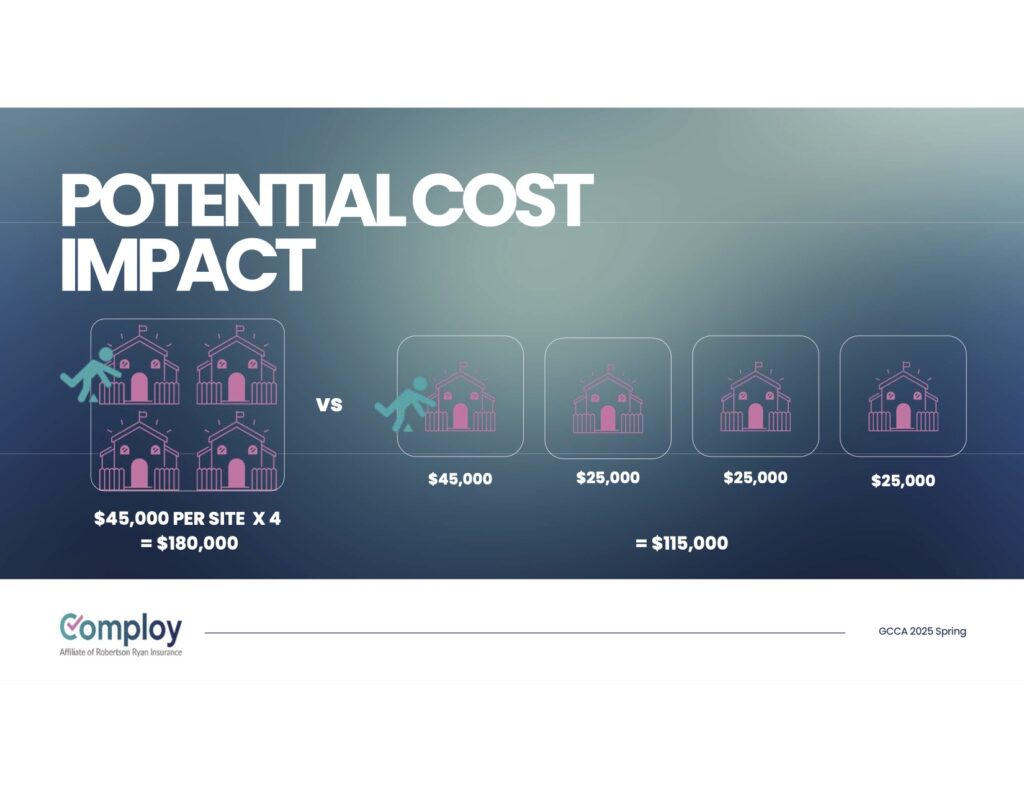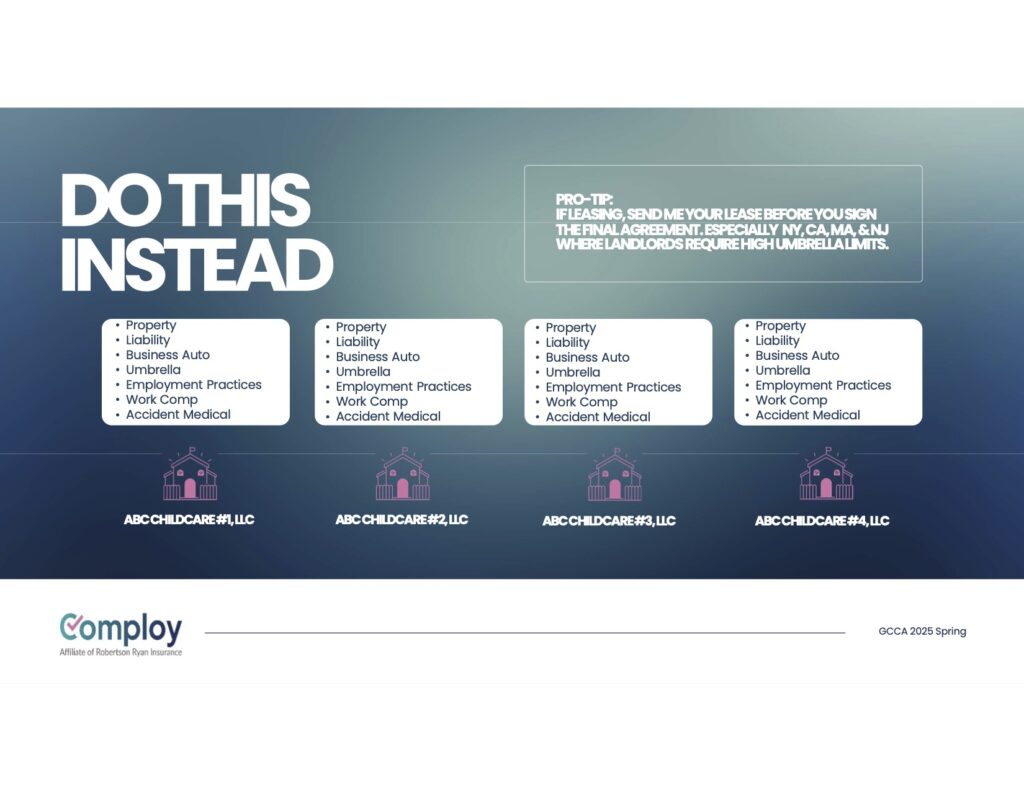
The childcare industry faces unique and evolving challenges, and insurance is a critical component of protecting your business and ensuring long-term viability. But how do you navigate this complex landscape effectively? In this interview, we speak with Comploy’s Samantha Phillips, an expert in childcare insurance, to explore two key areas: controlling your narrative to manage risk and structuring your insurance policies to safeguard your long-term interests. Samantha shares insights and offers practical advice to help childcare owners make informed decisions in an increasingly challenging environment. Whether you’re a new owner or a seasoned operator, this conversation provides essential information for navigating the world of childcare insurance.
What are the big topics on your mind right now regarding childcare insurance?
There are two big topics right now: teaching owners how to control their narrative, what that means, and also how to structure their insurance policies in a way that it looks after their best interest for the long term.
Let’s start with controlling the narrative. Do you think everyone is aware of the importance of doing that?
No, not at all. From my experience coaching over the past 14 months, it’s clear that not everyone understands the importance of controlling their narrative, especially when it comes to insurance. Unless an owner is personally facing a crisis, like receiving a non-renewal notice, many are unaware of the impact it can have on their business. It’s easy for them to dismiss the need for proactive steps because they’re so caught up in day-to-day challenges, and they often don’t realize how crucial it is to shape their story before a crisis hits.
So, is it fair to say we live in a misconception because the percentage of people impacted is still on the smaller end?
No, the impact is definitely much broader than most realize. The common misconception is that if someone has never filed an insurance claim, their coverage is secure. They think, “Why would my insurance company drop me if I’ve never given them a reason to?” But that’s a major misunderstanding.
Often, it’s not about the individual claim; insurance companies look at the broader picture, particularly when it comes to underwriting. They don’t just evaluate each policyholder on their own. Instead, they assess the entire childcare sector as a whole. If even one owner experiences a catastrophic loss, that single event can affect the entire group. So, the idea that “it won’t happen to me” just because they haven’t given their insurer a reason to cancel their coverage doesn’t account for the larger risks that impact the entire industry. Underwriting decisions are usually based on the overall trends, not just individual policies.
Do you think the experience people have with personal insurance, like car insurance, seeps into the business of childcare and contributes to this misconception?
Yes, I think that’s especially true for newer owners who haven’t had much experience with commercial policies. Most of us start with personal insurance, like car insurance, where once you sign up and pay, the coverage essentially renews on its own, year after year. That experience creates a sense of ease and can lead to the misconception that business insurance works the same way.
However, commercial insurance—particularly for the childcare industry—operates very differently. For most owners, policies don’t auto-renew. There’s a significant amount of manual work involved, from gathering detailed data to completing lengthy applications. These applications require manual review by underwriters, and every year the policyholder must go through a re-evaluation process. It’s not just a one-time thing; it happens every year, making the renewal process far more complex. Only about 5-10% of policies in the childcare space are automatically renewed, and that’s typically limited to workers’ comp or accident medical policies. Business auto, property, and liability policies all require manual underwriting and renewal, making them much more dynamic and hands-on compared to personal insurance.
I assume that one of the challenges when this goes sideways is not only the concern around business viability without insurance, but also the time it takes to get a solution in place. Has that felt like an avalanche of problems for the childcare owners you’ve helped navigate this process?
Yes, it definitely felt like an avalanche of problems at the beginning of 2024. We were navigating uncharted territory—trial and error, trying to figure out who would even insure childcare programs and where we could place coverage. It was incredibly stressful and challenging at first. But over the past year, things have started to smooth out, though I’m hesitant to say that too loudly, just in case I jinx it!
At the start, it was difficult, but we’ve spent a lot of time learning which insurance companies are still in the space and what their preferences are. Are they focused on large providers or smaller ones? Do they want to insure centers with over 150 licensed spots, or is there room for smaller programs as well? Knowing which carriers are still available and what they’re looking for has definitely made things more manageable, so now when someone approaches us for coverage, we can more easily identify the right solution for them.
The time aspect is still a major challenge, though. Right now, most underwriters require a 30-day lead time, which is why this process can’t be rushed. We need to start working on it well in advance—about 60 days before the policy’s expiration date—to collect all the necessary information from the client and submit the applications. If we don’t meet that 30-day lead time, we risk having fewer options. In some cases, like with one of our carriers, they won’t even provide a quote if we don’t give them that lead time.
The longer you wait to initiate the insurance process, the fewer carriers and coverage options you’ll have available to you, especially in certain states. For example, finding coverage in California is particularly difficult right now due to the market conditions. So, waiting until the last minute is a huge risk—it limits both your coverage options and pricing, making it much harder to find a suitable solution.
Let’s move on to the second thing you wanted to discuss – the importance of structuring policies. Can you elaborate on that?
Absolutely. Traditionally, we, including myself as an insurance agent, have often encouraged business owners to consolidate their policies. Take a multi-site owner, for example. If you own four separate legal entities and the real estate for each location, agents would typically recommend consolidating everything into one commercial package policy. This would mean covering all four buildings and their operations under a single policy.
However, over the past year, we’ve realized that this approach can create more risks than benefits. The issue is, the more you consolidate, the more you jeopardize all of your coverage lines if you experience just one claim. Let me explain: Imagine a fire at one building—only one of your properties is impacted, but since all your buildings are on the same policy, the loss history and the claim payout for that one incident affects all four locations. The fire should only have impacted that one building, but now it risks hurting the coverage for all your sites.
What we’ve shifted toward is minimizing consolidation while still ensuring each location has the same coverage types—property, liability, business auto, etc. For multi-site owners, we recommend structuring each location with its own policies under its legal business name. For single-site owners, we work to secure separate policies for property, liability, auto, and employment practices coverage. This way, if you have a claim in one area—say, an auto claim—it won’t impact your ability to maintain coverage in other areas, like liability or property. It’s all about isolating the risk to protect each piece of your business.
What is the financial impact of separating policies?
One of the main reasons agents used to encourage consolidating policies was because it seemed more economical—fewer policies meant less billing and lower upfront costs. While separating policies by location or coverage line might cost a bit more initially, the financial impact of keeping everything consolidated can be far more damaging, especially if a claim occurs. If all your policies are bundled together, a single claim can jeopardize not just the coverage for that one area (like property or liability) but potentially result in non-renewal for all of your coverage lines. In the end, you may end up having to piece everything together separately anyway.
Right now, the average cost per site for comprehensive coverage is around $25,000. However, if a single site has an open liability claim, that cost can jump significantly—from $25,000 to $45,000. Now, if you have four sites on a single policy, instead of paying $45,000 for just one, you’re multiplying that by four, bringing your estimated annual premium to around $180,000. On the other hand, if you had separated the policies, the total would have been around $115,000.


So, while you may pay a bit more upfront by separating policies, the cost of consolidating them becomes far greater if you experience a claim that impacts multiple sites. Given the rising frequency of claims—something we’re actively watching become more prominent every day—the potential financial hit is astronomical. For this reason, we’re strongly encouraging clients to restructure their policies to reduce that risk. It’s all about positioning them in a way that avoids these costly pitfalls.
It sounds like this is a form of risk management. Does it take a lot of time to get all these separate policies in place?
That’s an excellent question, and it’s a valid concern. Many agents will actually discourage separating policies because of the amount of additional work it creates. On average, from start to finish, it takes me about 20 hours of work per site to get your policies issued. So, when you multiply that across multiple sites, you’re essentially quadrupling the workload. However, it’s in the best interest of our clients, which is why we’re willing to make an extra effort. The reality is, most agents won’t tell you about this because they’re not eager to add that extra workload to their plate. But for the owners, it’s an important consideration.
Personally, I’m very detail-oriented and obsessively organized, which has helped me streamline the process, especially for multi-site owners. When a brand has established systems in place, it simplifies the data collection process as many of the policies and procedures are transferable across locations.
However, if you’re dealing with multiple brands or inconsistent policies and procedures, it complicates things. In that case, we would need separate applications and to fully understand the operations at each site. Having an organized and proactive agent makes a big difference. Without that, you’re essentially working against yourself. If you’re working with someone who’s hesitant to take on the extra work, it’s going to feel like you’re spinning your wheels and not getting very far.
To connect with Samantha or to learn more about optimising your childcare insurance, you can set up a meeting or reach out via www.comployhr.com.
If you or someone you know has a story to share, we’d love to have a discussion. Let us know via the website, Facebook or LinkedIn.
 If you enjoyed this post make sure not to miss the exciting and inspiring GCCA Spring Conference that brings together the brightest minds and most passionate professionals in Early Childhood Education across Georgia! This year’s event is packed with opportunities to grow, connect, and have fun in celebrating everything that makes ECE extraordinary.
If you enjoyed this post make sure not to miss the exciting and inspiring GCCA Spring Conference that brings together the brightest minds and most passionate professionals in Early Childhood Education across Georgia! This year’s event is packed with opportunities to grow, connect, and have fun in celebrating everything that makes ECE extraordinary.
